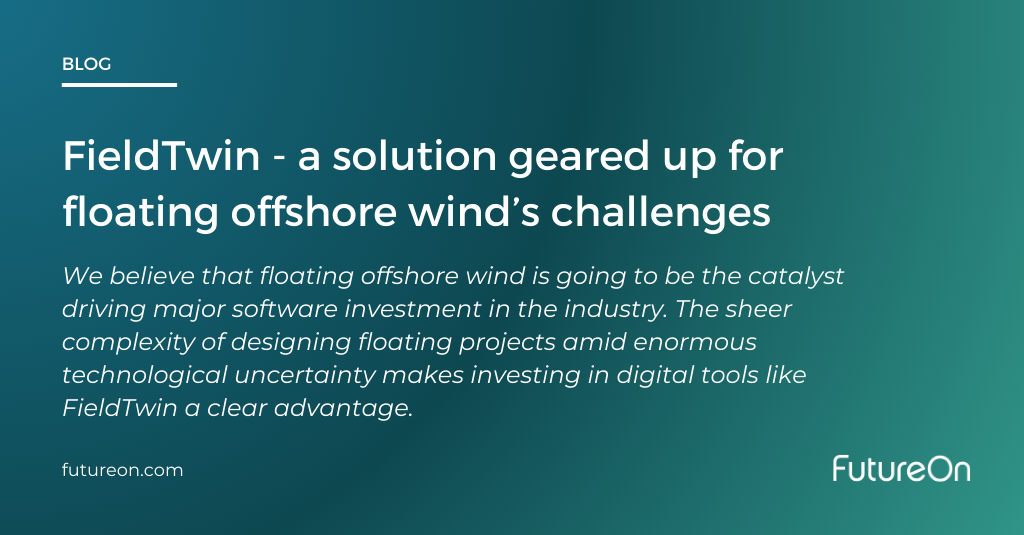FieldTwin – a solution geared up for floating offshore wind’s challenges

Adam Duffy
VP of Energy Transition
It’s been something of a difficult year for the offshore wind sector in the UK against the backdrop of a challenging policy landscape, continued supply chain pressures and concerns emerging over port capacity.
After the latest allocation round of Contracts for Difference in the UK, which failed to attract a single bid from an offshore wind operator, there was a feeling that mood at the Renewable UK Floating Offshore Wind 2023 conference would be more than a little subdued.
The reality? While more sober than previous events, developers were optimistic on their portfolios, and contractors were still busy growing their teams. For FutureOn, we share this optimism, not only about the collective will of the industry to overcome these challenges, but about the opportunity for FieldTwin in the floating offshore wind sector.
Our objective in attending the Aberdeen conference was to showcase the FieldTwin platform with the UK floating community and gather feedback on both our latest features and our broader vision for an integrated digital twin of the project phases in offshore wind.
We believe that floating offshore wind is going to be the catalyst driving major software investment in the industry. The sheer complexity of designing floating projects amid enormous technological uncertainty makes investing in digital tools like FieldTwin a clear advantage.
In FieldTwin, you can design a field in a day, collaborate across your entire team, swap out a different foundation or configuration, then share the results with external stakeholders. It’s the ability to streamline the design workflow that capture the attention of developers end EPCs.
There are around 80 floating foundation designs being actively considered in the sector. Even 20 would be too many. Developers are under tremendous pressure to standardise and cost-down before there are any industrial standards on which foundations to use where and under what conditions. Compared to fixed-bottom wind, there are so many more complicating factors and so much less validated data available.
Most developers are sandwiched between the push-pull factors of standardisation. They see the benefits of standardising as much as possible so they can mature their supply chains and forge strong commercial partnerships with manufacturers. On the other hand, they want to retain the flexibility to respond to the challenges and needs of different sites with different technology.
FieldTwin becomes invaluable to those developers by providing a virtual tool where they can plug in every foundation model they are considering and narrow down the suitable options. During the design phase, the team can build better and faster. During the construction phase, the team can collaborate seamlessly with contractors and other external parties. Fixed-bottom projects can benefit from FieldTwin for the same reasons, but the advantage to floating is simply more obvious because of the scale of the uncertainties.
It’s been a sobering 12 months in the industry. Costs have escalated to levels previously unthinkable on commodity price gyrations and soaring interest rates. Those are not the only variables: Scotwind auctioned off almost 25GWs to great fanfare, much of it to proposed floating developments, but the grid capacity to accommodate all those projects doesn’t exist yet. At best, there are suitable grid connection points planned for over 10GWs.
Despite those challenges, no one is giving up on floating wind. instead, they’re looking around for what would give them an advantage amid escalating challenges.
Some of our clients in oil and gas are bringing FieldTwin with them to the offshore wind industry. Their intent is to disrupt the incumbent players.
Clients in upstream have used FieldTwin to complete front end engineering design in half the time for half the cost, reducing the time to first energy. Time is money in any commercial set-up, and this resonates more deeply at 10% interest rate. Pulling in the project timeline by two years can make all the difference in viability.
With FieldTwin, we encourage clients to make it their own. They don’t need to get permission from us to adapt or adjust it. This is because FieldTwin is designed to be API-first and fully open to integration with new software. We saw this in action at Aberdeen where one of our clients – an offshore energy service company – was demonstrating it on their booth as a central component of their pre-Engineering, visualisation and stakeholder engagement workflows.
FieldTwin is a collaborative digital twin from the start – across the joint venture and connecting both internal and external stakeholders. It’s a solution that ensures that everyone is on the same page and moving in the right direction.
With the right mindset, and the right tools, the floating wind market can tackle the challenges head-on and take its place as an essential piece of the energy transition puzzle.